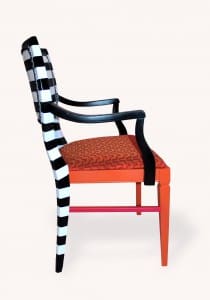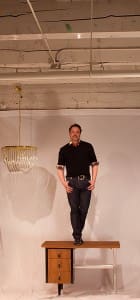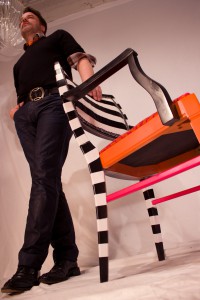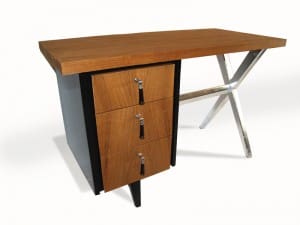 REVAMPMAN
REVAMPMAN
Written by G. Pollard
If ever there was a savior for discarded furniture then Carter Averbeck is it. He transforms the forlorn and forgotten pieces left by the wayside into works of vibrant art ready to settle once again into a home with panache.
“I call it the Lazarus Effect” Carter jokes, “We bring life back from the dead with each piece of furniture that comes to our workshop.” Seeing the state of many of the items within his studio at Omforme Design, it is with absolute wonder that some of these items would even be worth the effort. Tattered seating on chairs, beat up wood dressers from the mid century, a heavily cat clawed couch sits in the corner waiting to be saved.
“Our mission is quite clear; we want to infuse value back into these pieces while doing our planet a favor at the same time by not adding to the landfills.”
 The concept comes on the heels of Carter’s long existence within the interior design industry witnessing the staggering amount of goods created each year for sale to an all consuming public. “It’s mind boggling how much is being produced in every facet of design. Do we really need 7,000 sofas to choose from?” he quips. He’s right, especially when so many beautiful things already exist that are paid no attention past the next trend in design.
The concept comes on the heels of Carter’s long existence within the interior design industry witnessing the staggering amount of goods created each year for sale to an all consuming public. “It’s mind boggling how much is being produced in every facet of design. Do we really need 7,000 sofas to choose from?” he quips. He’s right, especially when so many beautiful things already exist that are paid no attention past the next trend in design.
The furniture industry has been famously slow to adapt to being environmentally green despite all the hoopla surrounding public relations efforts. The industry now tops the list as having the most waste produced; roughly 13 million tons a year in the United States alone. That’s more than the automobile and clothing markets combined. More and more design firms are vying for the opportunity to produce their furniture designs on a large scale in an already saturated market. Eventually we will run out of natural resources to handle the demand. There is a way out of this potential mess but according to Averbeck, it’s going to take a huge paradigm shift in consumer thinking and the choices made in electing to purchase vintage or refurbished items over new.
 He has a compelling case. The first example is an iconic item that has been in existence for centuries – the Louis XVI chair. It’s popularity has spanned time with an endless production run by many manufacturers. “The furniture industry closely follows the fashion industry. It’s a case of out with the old and in with the new” says Carter. Though furniture manufacturers would rather you throw out the old chair in favor of the new version – which is really the old version only slightly different in color, size, or styling. One of the benefits that older furniture has over its newer counterparts is construction. Older pieces are generally built better. Back then furniture pieces were built during a time when durability was the main focus and not mass production runs where sacrifices in quality are made in the quest for larger profit margins.
He has a compelling case. The first example is an iconic item that has been in existence for centuries – the Louis XVI chair. It’s popularity has spanned time with an endless production run by many manufacturers. “The furniture industry closely follows the fashion industry. It’s a case of out with the old and in with the new” says Carter. Though furniture manufacturers would rather you throw out the old chair in favor of the new version – which is really the old version only slightly different in color, size, or styling. One of the benefits that older furniture has over its newer counterparts is construction. Older pieces are generally built better. Back then furniture pieces were built during a time when durability was the main focus and not mass production runs where sacrifices in quality are made in the quest for larger profit margins.
Another surprising factoid is that popular furniture styles actually change very little over time. Much of the new furniture designed today still relies heavily on older versions as inspiration. A modern classic sofa is still a modern sofa no matter what the new fabric or frame is, and a brand spanking new version of a farm table is still based off the old farm table from 90 years ago. So why not go out and get an existing piece of furniture? The answer is that many consumers just want new for the sake of it being new and older items,..well, are used. Yet in most cases there’s nothing wrong with previously owned items other than they don’t have that new car smell so to speak and a little updating is what’s needed.
All it takes is imagination to turn an ugly duckling, say desk, into a handsome piece. Averbeck has lots of it, which is why his pieces are more than just a paint job into shabby chic territory. Decorative metal leafs, lacquers, flowing sculptural facades adorn his work as does unusual color combinations that turn everything into a designer quality item. When asked about why he transforms furniture instead of refinishing them into original condition, Averbeck has this to say: “I look at it like this; If you’ve had the same hair style for 30 years, great! You’ve found what works for you. But most of us have evolved over time. Furniture can do the same thing.” His proven formula for adapting older pieces to current trendiness has found fans from private clients to local boutique shops where his pieces sell out quickly.
Carter’s smile is apparent when he mentions, “I’m very happy doing this, it feels good to save our planet and make things beautiful again. Sometimes when I show people what one of our chairs used to look like before we got to it, they don’t believe it’s the same chair!”
For more information, you can reach Carter and his team at Omforme Design by calling 855-OMFORME or on the web at OmformeDesign.com.


